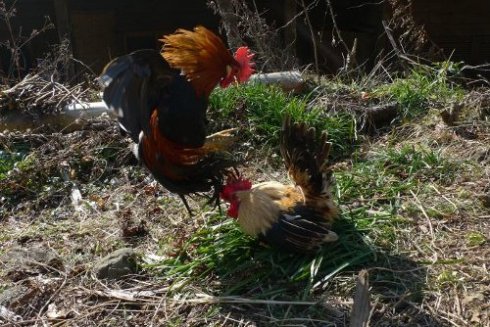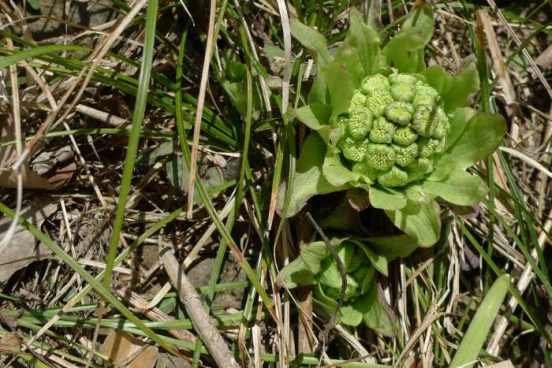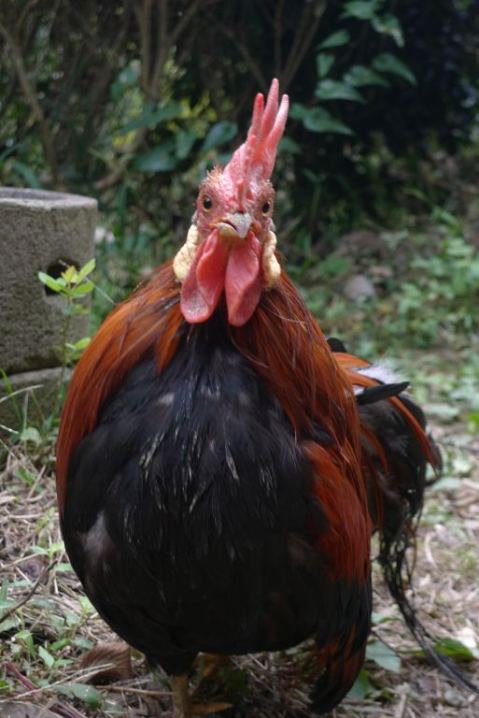Let it Bleed II
March 22, 2013
Here is Asako’s latest Les chroniques purple contribution. Originally posted March 16, 2013.
We have two pairs of chabo — Japanese heritage breeds of chicken. They are much smaller than regular chickens and thus lay smaller eggs but we chose chabo instead of the typical hybridized egg-machine chickens. Be it creatures or plants, we prefer the strong, close-to-wild ones that can take care of themselves. Chickens that have been selectively bred for high productivity require special food to keep up with the nutrient, mineral and protein demands that come from pumping out so many eggs. Favoring particular genetic traits always comes at the expense of others and so these chickens are prone to illness and have usually lost the ability to efficiently forage their own food.
Our four chabo all hatched last summer, making this their first spring.
Their names are Bully, Obasan (Japanese for auntie), Chabosuke, and Chaboko. Chabo tend to pair bond and are ‘faithful’ to their partners. Because of this it is traditional in Japan to keep pairs of chabo – one rooster for every hen. Our two pairs are descended from different breeds, one of which produces roosters that are considerably larger. Due to this difference in body size, Bully was always bullying Chabosuke (hence his name). Recently Chabosuke began taking out his frustration on the girls and sometimes on me too! Then one day he decided enough was enough. It was time to confront the bully.
The challenge started with a high flying kick to Bully first thing in the morning. But mostly their fighting method is more like sumo wrestling. They stand off, puffing up their collars, staring at each other. One lunges at the other’s comb or wattle, pecking it with his beak and pulling on it to drag down his opponent’s body. This is the first time I have seen chickens fight. It was a frightening scene: blood on their faces, on their feet, and splattered all over the ground. They wouldn’t stop. I became worried that it might not end until one was seriously injured, crippled, or even killed.
After thirty minutes of carnage I stepped in, and put everybody into their separate houses to cool down (interestingly, the girls didn’t care about the boys’ fighting at all, and were busy with their usual scratching up the soil and munching away on things while right next to them the voltage was at maximum!).
Next morning I opened the doors of the two chook houses and, within seconds, witnessed the same scene as yesterday. After a short while I shunted everyone back inside their respective houses and closed the doors again.
Not knowing what to do, I called the guy who had given the chabo to us. He said, “I don’t know. I never know what they are thinking. We can only observe them. They will figure it out for themselves.” I asked if it was a good idea to move one of the houses away from the other. “No”, he replied. Of course, I don’t know what they are thinking either! I made up my mind to stop interfering and see what would happen, to let it go all the way even if the outcome was one I didn’t like.
Next morning it started again. This time I didn’t interrupt but just observed the fighting. It seemed like Bully was losing, trying to run away from Chabosuke. He looked confused, like he couldn’t comprehend what was happening. But Chabosuke wasn’t letting him escape. They ran beyond the perimeter of their normal playground. I patiently followed them wherever they went just to keep an eye on where they were. At one point Chabosuke knocked Bully down. He seemed completely off-switch, blood all over him. It looked like Chabosuke wasn’t going to stop attacking him. I reached in to the fray, grabbed Bully and held him tightly to my chest. After having a good look at the damage I put them into their houses again.
And I moved Bully’s house far away from Chabosuke’s.
I thought by now Bully would understand that he was no longer No.1. And here, in this new location, he could enjoy a new life with his partner, Obasan.
Next morning, they were having breakfast at their now widely separated locations. It seemed a quiet, gentle morning … until Chabosuke started crowing loudly. Sure enough Bully, hearing the crowing, rushed off in the direction of Chabosuke. At this point I just walked away. I went back to my daily tasks but I kept thinking about it.
I had lived in cities my whole life until recently when I moved to the mountains to live within nature. After two years, I thought I was getting better at it but this incident showed me that I am still far away from nature, trying to force other living things to fit my view of the world, domesticating them into cute house pets and ignoring their instinctual natures. To ‘protect’ them both I had tried to prohibit them from fighting. But then, are they the only ones to have been domesticated?
Recently I went to the city. Around the station there were many signs prohibiting people from doing all sorts of things: No parking! No smoking! No talking on mobile phones! Don’t litter! Don’t stand in front of this line!.… Red and yellow is everywhere. The colors of security and safety, we are led to believe, are protecting people from one danger or another, some inappropriate behavior or filthy habit, but aren’t they actually preventing people from listening to their intuitions, to their instincts and senses, redirecting the very process of their thinking? Domesticated animals. And I am one of them.
The situation calmed down that day. Chabosuke lost both of his spurs and gave up the fight. Bully kept his dignity after all. They went back to their usual roles, but only until Chabosuke’s spurs re-grow, perhaps.
Let it Bleed
February 18, 2013
Originally posted on Les Chroniques Purple, February 16, 2013.
During a recent spell of particularly warm days a paper wasp appeared on the toilet wall. In subsequent days the temperature plummeted and (if she has moved at all) her movements have been barely perceptible. Coaxed from hibernation by the arrival of spring. Or, maybe not…
Although the sun rises higher in the sky with each passing day the nights remain crisp—cold clear skies and shimmering stars. This cold dark energy has dominated the past months. During this time many plants concentrate their vital energy, their ki, in root systems sunk deep in the relatively warm soil. There are also plants that have hugged the ground closely protecting themselves from the brutal wind that whips up the valley. Now, here and there, fukinoto, the small buds of the giant butterbur, have begun popping up from the ground. Fukinoto we deep fry or boil and mix with miso paste. It is a bitter tasting plant. The bitterness of many spring wild edible plants stimulates the digestive system and helps flush out the residue accumulated through the winter’s heavier fare. Fukinoto is a plant that reminds us of winters passing and the arising of spring.
It is a commonplace that farmers or those who “live close to the land” are more keenly attuned to the seasons. For us, living as foragers and gardeners in a forest, what we have become more aware of is the bleeding boundaries of the seasons across time and space. Spring, summer, autumn and winter as discrete seasons with “official” starting dates—be they astronomical or calendar-based—seem to have little to do with the dynamic flow of constant and gradual change that we experience. The drum roll of spring beginning somewhere in the depths of winter. The fall crescendo building momentum in the torrid days of summer.
During February—usually the coldest month—the morning ground glistens with a carpet of frost. The chickens struggle to drink water through the crust of ice that covers their bowl during the frigid nights. Winter scenes to be sure. However, late morning, as the sun crests over the mountains to the south, a warm glow fills the valley and a different scene is revealed. The tiny white flowers of chickweed peek out from the plants’ increasingly lush growth. Thousands of frog eggs become visible (how long have they been there?) on the bottom of a small pond. The first tentative blooms appear in the tree canopy.
Behind our house a path cuts across the slope of the hill. Above the path, where the sun hits early, where a bamboo grove shelters the land from strong winds, where the slope of the hillside encourages frost to move along without settling, daffodils have been glorying in days of spring for weeks already. It is here that the florets of nabana, a wild mustard, can be picked first. Below the path, in the depths of the valley, where the sun comes late, where the land is fully exposed to the gales and where frost settles thickly it is still the midst of winter. Here the nabana will arrive much later but will continue producing delicious florets for much longer.
For the forager attuning to the seasons, or “eating seasonally,” is a deep practice. It is an invitation to learn the lay of the land intimately; to learn the precise gradients in temperature caused by the differing angles of the sun as it touches a hillside; to develop a sense of the microclimates offered by a rocky outcrop, a tree, a body of water; to observe where the soil is most, or least, fertile. We overlay this information with what we have learned from the plants: preferences in soil fertility and warmth, preferences in amount of sunlight exposure relative to air temperature, how much rain in which temperature range will spur the fruiting of a particular fungi… Of course this is not to be studied in books then applied in the field but learned by doing, slowly. And anyway, it can hardly be said that it is consciously applied at all but rather, in a most subtle way, the feet, the eyes, the hands are guided.
– Asako Kitaori & Dion Workman
On the Road
January 3, 2013
Well look at that…The end of the world has come and gone (again) and we’re all still here! With the latest apocalypse/salvation distraction behind us we’re back to the reality of the slow catastrophe daily unfolding and the responsibility for doing something about it.
While the Japanese have just voted in a right-wing, pro-nuclear nationalist “strong leader” to end their woes (not that there was much of a choice – being a modern democracy an’ all) Asako and I have a different idea. In January we’re hitting the road (well, the tracks actually) to propagandize the people and hopefully inspire a little action.
During January 2013 we will be giving presenations in Hamamatsu, Nagoya and Tokyo about our life and work at Shikigami. Through photographs and stories we will discuss our approach to permaculture, deep ecology, forest gardening and gift economics.
Hamamatsu Wednesday January 9, 13:30. Payaka: 4-19-12 Kamoe, Naka Ward, Hamamatsu Permaculture Chubu, Hamamatsu
Nagoya Sunday January 13, 14:00. Tokurinji: Aioi-28-341 Tenpakucho Oaza Nonami, Tenpaku Ward, Nagoya Permaculture Chubu, Nagoya
Tokyo Friday January 18, 19:30. One Kitchen: 3-26 Arakicho, Shinjuku-ku, Tokyo
2013年1月、浜松、名古屋、東京にて、Shikigamiでの私たちの生活と仕事についてのプレゼンをします。写真を見せながら、パーマカルチャー、ディープエコロジー、フォレストガーデニング、ギフト経済への私たちなりの取り入れ方について話します。
1月9日(水) 13:30 Payaka(パヤカ) 静岡県浜松市中区鴨江4-19-12 詳細はパーマカルチャー中部
1月13日(日) 14:00 徳林寺(本堂裏のギャラリー・ハスタクティ1Fにて) 愛知県名古屋市天白区天白町大字野並相生28-341 詳細はパーマカルチャー中部
1月18日(金)19:30 One Kitchen 東京都新宿区 荒木町3−26 サウスウィング荒木町2F奥


